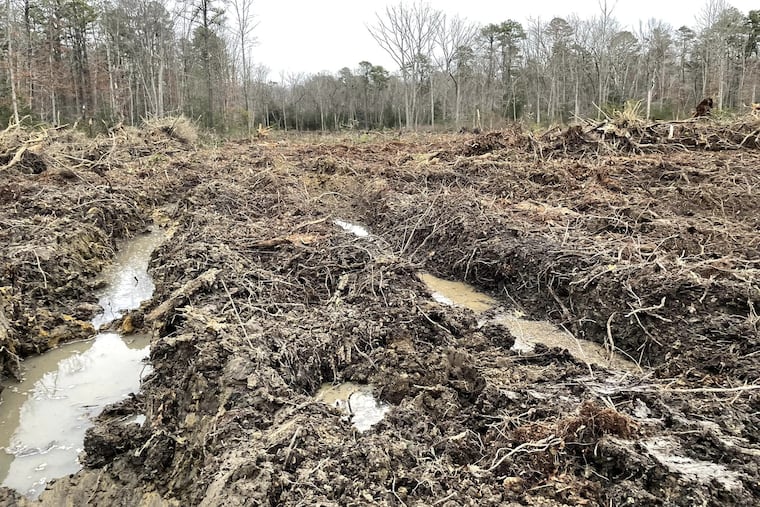New Jersey Department of Environmental Protection penalizes itself for destroying protected land
Environmental groups were outraged when a division of the New Jersey Department of Environmental Protection began clear-cutting acres of mature forest and wetlands in Gloucester County.

Environmental groups were outraged when a division of the New Jersey Department of Environmental Protection began clear-cutting acres of mature forest and wetlands, as well as removing all trees and stumps at the Glassboro Wildlife Management Area in February to create habitat for the American woodcock.
Apparently, DEP officials agreed: This week the department’s Bureau of Coastal and Land Use Compliance and Enforcement issued a notice of violation to the Division of Fish and Wildlife for illegally clearing 15 acres, which included protected wetlands and the areas that border them.
The DEP acted to issue the violation to itself after widespread complaints from the NJ Conservation Foundation, Pinelands Preservation Alliance, South Jersey Land and Water Trust, and Citizens United to Protect the Maurice River. The groups sent a letter alleging a violation of the Freshwater Wetlands Act, saying there had been no public hearing on the plan and called for a halt to the project.
The DEP suspended the project on March 10.
Tom Gilbert, co-executive director of the New Jersey Conservation Foundation, said the DEP’s attempt to save one bird damaged three acres of habitat for the state’s threatened barred owl and endangered red-shouldered hawk. Gilbert said nearly 12 more acres described as having “exceptional resource value” were cleared of vegetation and soils by Fish and Wildlife’s habitat project.
“This should never have happened, so they must also take steps to improve their clearly inadequate internal review process and meaningfully engage the public,” Gilbert said. “No significant projects should move forward without being subject to comprehensive review with public input. Our public lands deserve better.”
Under conditions of the violations, Fish and Wildlife must submit a plan to restore the site within 30 days and opened the process to the public.
“NJDEP’s decision to clear-cut 21 acres of mature forest in the Glassboro Wildlife Management Area and impact critical wetlands is reprehensible,” said Anjuli Ramos-Busot, New Jersey director of the Sierra Club. “They have caused irreparable harm to an area with trees over 100 years old, destroyed rare and endangered animal and plant species habitat, and damaged critical wetlands. The department failed to have adequate public input and unfortunately since the state has minimal regulations on how to manage its public forests, there is no accountability. This is a failure of governance.”
The Bureau of Coastal and Land Use Compliance and Enforcement determined that about three acres of freshwater wetlands that were damaged in the clear-cutting had previously provided habitat for the barred owl and red-shouldered hawk. In addition, 12 acres within a freshwater wetland transition area were cleared of vegetation and soil.
“Pinelands Preservation Alliance thanks NJDEP for being accountable for their actions, but we also need the public to trust that current projects are being evaluated with appropriate rigor,” said Jaclyn Rhoads, assistant executive director of the alliance.
Rhoads said the DEP should provide a list of projects it is working on for public view.
“This demonstrates a real lack of overall planning for our public natural resources. We can do so much better,” Bob Williams, a certified forester with Pine Creek Forestry, said in an email.
The department wrote on its website Feb. 1 that the work sought to create 21 acres of habitat for the American woodcock, a member of the sandpiper family that uses its long, narrow beak to forage for earthworms in damp soil. The project was designed to create a “meadow habitat.”
The violation notice includes the threat of penalties, but it was unclear how that might work if the DEP fines itself.
Larry Hajna, a DEP spokesperson, said the DEP issued the letter of violation on April 6, “for unauthorized regulated activity.”
He said that by the end of April, the DEP will issue a penalty assessment. As a condition of settling the violations, Fish and Wildlife must propose additional environmentally beneficial measures.